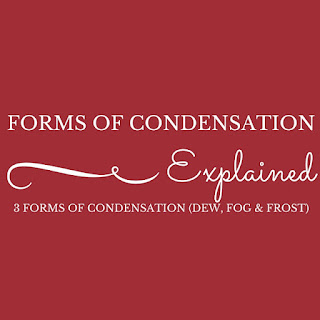3 Forms Of Condensation (Dew, Fog And Frost)
Different forms of condensation are condensation near the ground and in troposphere that includes dew, fog and frost.
 |
| 3 Forms Of Condensation (Dew, Fog And Frost) |
Forms of condensation
Different forms of condensation are :
- Condensation near the ground: Dew, for, haze or smog, Frost.
- Condensation in troposphere: clouds.
Dew :
condensed moisture as a consequence of contact cooling is dew. It is a form of direct condensation of water vapour to liquid drops that deposit on any vegetative or hard rapidly cooling object. Formation of dew on grass cover, leaves, metallic surface, paper pieces, window glasses etc is of common observation in early morning. Dew visible on non living objects may be from atmosphere water vapour or from water vapour from underlying moist Surfaces, following rain. In the case of plants surfaces, in addition to the above two, water transpired by lower surfaces condense on upper colder surfaces . Favourable conditions for due formation are :
• cool and long night as in winter.
• still air (no movement of air).
• low temperature.
• high water vapour in the atmosphere at sunset.
Dew is important in agriculture and Ecology in several ways :
• foliar absorption of dew is an important factor in survival of natural vegetation in arid regions.
• the due benefits dryland winter crops like wheat and gram, especially at reproductive stage.
• dew reduces transpiration losses of water and minimises crop water requirements.
• increased humidity due to dew formation in the crop canopy accelerates pest and disease build up.
Fog :
Almost microscopically small droplets of water condensed and suspended in the air near the ground to reduce horizontal visibility are called fog. Fog is formed when the air near the ground falls below dew point temperature, wind is calm and RH is more than 75 percent. Physically, fogs are same as clouds. Unlike clouds, fog is formed due to radiation cooling or movement of warmer air over cold soil. Cooling of air by contact and mixing or saturation of air by increasing vapour content also causes fog. Fog is formed near the surface where as cloud is formed when air rises up and cools adiabatically. Diameter of the particles forming Fog varies from 0.1 to 0.01 mm.
Fogs are also formed when air moves upward against mountain slopes. The moving air has high relative humidity. Upward moving air cools by adiabatic expansion. This fog becomes denser and is maintained against high wind velocity. Rapid cooling due to fast rise of air up the slope upsets the downward transport of heat by turbulence and results in fog. The blend of fog and smoke, called smog, is more common in city and industrial areas. Mist is wet hygroscopic particle suspended in the air. It is less dense fog. It disappears with rising sun. Fog is an important source of moisture for natural vegetation. It can benefit crops through its contribution in water balance maintenance.
Frost :
when air temperatures at screen level drops down to or below the freezing point, water vapour sublimates (passes directly from solid to liquid phase) and ice crystals are formed. This crystals are called Frost. Frost is not frozen dew. It is the ice formed directly from water vapour by sublimation. Condensation for Dew and Frost formation are practically same. However, dew forms when condensation occurs on cold objects above the freezing point, whereas frost forms when condensation take place below freezing point. Frost may form due to excessive radiational cooling of ground surface in clear and fairly calm and dry weather. It may also occur due to advection (wind currents bring air from cold regions).
Freezing causes injury to plants by extracellular ice formation and cellular dehydration. When cell water content is high, ice may form within the cell and kill Protoplasm. When ice from outside the cell, injury occuts during thawing when extracellular ice melting leads to a more rapid swelling of the cell wall and Protoplasm, which gets torn apart in the process.
Frost is always injurious to vegitation. Crops like castor, tobacco, tomato, cotton, cumin, funnel etc are more affected then other field crops. Frost damages the fruit in orchards during winter. To reduce the damage, surface mulching, irrigation, use of large fans to blow away condensing water vapour and large heaters are used. Irrigation during day time is the common practice to save potato from Frost. In India, Frost is limited to more colder Northern parts (Jammu and Kashmir, parts of Punjab, Haryana, Delhi, UP and MP).






The Le_Meridian Funding Service went above and beyond their requirements to assist me with my loan which i used expand my pharmacy business,They were friendly, professional, and absolute gems to work with.I will recommend anyone looking for loan to contact. Email..lfdsloans@lemeridianfds.com Or lfdsloans@outlook.com.WhatsApp ... + 19893943740.
Here are the products of Loan we deal in !!
Personal loan,Business Loan, Home Loan, Student Loans,Mortgage Loan
(Loan against Security/Property), Car Loan..etc. For any Assistance or
Query please Contact us Via Email: capitallendinghelpdesk@gmail.com
whatsap: +91 8857047852